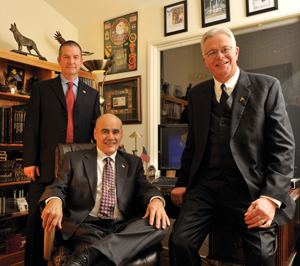A former Vietnam veteran is leading the effort to honor an underappreciated breed of military worker
Article by Forrest Glenn Spencer / Photographs by Tom Lynch

After spending a night in the jungle, Sgt. John Burnam and his 80-pound German shepherd scout dog, Clipper, concealed themselves with members of a U.S. Army patrol in the vegetation alongside a trail used by North Vietnamese Army (NVA) in the Tay Ninh Province, some 80 miles west of the former city of Saigon. In the summer of 1967, their mission was to capture a courier for interrogation.
Clipper had helped locate the trail used by the enemy in the jungle the previous day and, a few hours after dawn, alerted Burnam of a presence by holding his ears and head high, a training signal used as a means of communication. Burnam soon spotted a young NVA soldier riding a bicycle, with a rifle slung over his shoulder and two canvas bags attached to the back fender.
Clipper’s warning soon spread throughout the patrol. The target drew closer, and Burnam remembers his adrenaline rising as the bicyclist neared. As soon as the enemy solider rode past, Burnam released the German shepherd, who lunged and knocked the courier off his bike, granting the American soldiers enough time to swarm their target. It was a successful mission with no American causalities, thanks largely to one of the 4,000 highly trained dogs that served in the Vietnam War.
“The most well-trained solider is never as good as a dog,” says 62-year-old Burnam, who today resides in Bethesda, Md. “Clipper would make judgment calls about a trip wire or fresh set of enemy footprints on the ground. Part of that [is] from training; the other is their natural instinct.”
The story of Burnam’s war and of the scout dogs is told in his memoir, “A Soldier’s Best Friend.” Even after Burnam returned from his second and final tour in Vietnam to his home in Littleton, Colo., in 1968, Clipper remained in active service overseas. There was no homecoming for service dogs. Officially, 281 dogs were killed in action in Vietnam, but a majority of the scout dogs were labeled “expendable equipment” and left behind, euthanized as America withdrew.
But Burnam says he felt the dogs’ sacrifices in Vietnam, as well as Iraq and Afghanistan, should not be forgotten, so for the last several years he has actively been pursuing the construction and national recognition of a monument in the Washington, D.C., region for the dogs who have served in all our wars.

Burnam’s Memoir
In 1991, Burnam reunited with his best friend from the war, fellow soldier Kenny Mook. At the time, Bernam was living in Fairfax. He came to Northern Virginia in the late 1970s while still in the U.S. Army to manage a computerized personnel management training program he created, which later earned him a Legion of Merit medal for his efforts. Upon receiving an invitation from his wartime buddy, Burnam traveled to Mook’s farm in Pennsylvania, where they recounted their Army experiences. In 1966 the men had served together for a few months until a fierce battle separated them for the next 25 years when Mook was injured and airlifted out.
“We were finishing sentences of the other,” Burnam recalls of the reunion. “That was a significant time for both of us—our first battle together, facing the enemy together, the jungle.”
With his friend’s urging, Burnam started putting together notes for a book about serving in Vietnam. He thought the endeavor could be told in 20 pages, but in time a larger project took shape. The first portion of the book covered Burnam and Mook’s times as infantrymen, but the majority described Burnam’s time as a dog handler. As he wrote more of his memoir over time and showed chapters to other people, they encouraged him to publish it. Burnam eventually had 5,000 copies printed under the title, “Dog Tags of Courage.”
The publication of the book and its promotional tour, along with Burnam’s involvement with national dog handlers associations and participation in a few documentaries—including Discovery Channel’s “War Dogs, America’s Forgotten Heroes”—prompted him to perceive the need for a nationally recognized monument. Burnam says he saw it as a way to honor the handlers and the war dogs, to educate the public of their role in our nation’s defense, and offer closure for other dog handlers who are affected by the experience of war.
Today, the training is conducted by the 341st Dog Training School at Lackland Air Force Base, Texas, which is the world’s largest facility providing working dogs for the U.S. Armed Forces, as well as federal agencies. German shepherds, Dutch shepherds, Belgian Malinois and Labrador retrievers are the school’s primary breeds, and more than 650 dogs and handler are processed through Lackland annually. The dogs are no longer viewed as expendable property. They are deployed for eight years, retired from active service and placed for adoption.
By 2001, with the help of two former Vietnam War dog handlers, Larry Chilcoat and Richard Deggans, a foundation was created by Burnam to help in their efforts, especially fundraising. In fact, late last year, JBMF, Inc. was designated under law as the principal non-profit authority to build and maintain a national monument to honor the United States Armed Forces working dog teams. But to secure national recognition, a member of Congress was needed to start the process.
Congressional Proceedings
Rep. Walter Jones (R-N.C.) was asked by a constituent, Dennis Lewis, nearly five years ago to join him and others in the community of Pikeville, N.C., for a gathering of war dog handlers. Jones, who enjoys traveling in his district, agreed. It was at this event that Jones heard about Burnam’s efforts of a national monument for the war dogs, and soon, both men met and discussed what could be done.
“I was interested in helping because I thought it was a worthy cause,” Jones says. “They weren’t asking for taxpayers’ money. All they wanted was land to build a national monument.”
In April 2006, Jones introduced legislation to authorize the establishment of a national war dogs monument in Washington, D.C. Nearly three months later, the House National Parks Subcommittee met to consider the bill.
Several people gave testimony before the subcommittee, including Burnam and Sue Masica of the National Park Service. While the military dogs’ efforts were deemed “meritorious” she reported that her federal department opposed the establishment of the monument on NPS land because it “would not fit into the category of authorized military commemorative works” as specified under the Commemorative Works Act.
A compromise was quickly sought.
“Someone from the Pentagon was attending the hearing,” Burnam says, “and they offered to help us find a military installation [for the monument]. The legislation was rewritten and more meetings held, Fort Belvoir was suggested to be the site because that’s where they have plans to construction the National Museum of the U.S. Army.”
With the congressional process grinding forward, designing the monument and calculating costs for construction was necessary.
And then Hollywood called.
‘MOE’
After Burnam’s first edition of his memoir sold out, Union Square Publishing purchased the book and re-released under its current title, “A Soldier’s Best Friend.” Universal Studios purchased an option and drafted a script, asking Burnam to serve as a technical advisor. But nothing more came from Universal’s interest, and their option lapsed. Then in 2004, British Columbia author Marnie Wooding saw the Discovery Channel’s documentary on the war dogs.
“What really struck me about the Vietnam service dogs were the handlers,” Wooding says. “Here were [older veterans] talking about dogs that died in the 1960s and 1970s, and they were still very emotional about telling their stories. And I thought there was something behind that because it made me cry.”
Through her contacts, Wooding connected with Burnam, whom she remembered being featured in the documentary and whose memoir she read after viewing. “It was a very honest, personal account of a young guy in Vietnam,” she says, “so I approached him to write a screenplay based upon his book.”
Burnam agreed to the endeavor. Wooding then showed the book to her business partner, a cinematographer based in Vancouver and army veteran, Jan Kiesser. Together, they operate Crooked Door Entertainment. Kiesser, too, saw the potential of a film. “I remember looking at photos of John Burnam at that time, and he looked so young. Here are these young men in a situation that their life experience had not prepared them for. The stability in their life was their dog. I wanted to explore that situation.”
For the next several months, Wooding wrote the first draft of the screenplay, titled “MOE,” with Burnam serving as consultant. Wooding and Kiesser also secured a director for the project. But the script would not be an adaptation; rather, it would be a fictionalized story based upon the book and touching upon its themes about the value of life and sacrifice.
“It’s also a love story between a guy and his dog set in an unusual place,” Wooding says. “And the vulnerability. That’s an aspect of that war we did not know about. I think they’re very touched by the journey.”
Wooding and Kiesser are working to secure financing for the film.
Securing The Monument
Burnam and his partners began meeting with officials from the Military Working Dog Program and Fort Belvoir earlier this year to secure final approval of the design, which they believe will be accepted. The National War Dog Monument would be an open-air memorial 5,000 square feet in size, constructed of granite and stone. The monument would be surrounded by vegetation, bushes and trees, and it would include a small wall describing the role dogs have performed in our nation’s security. The centerpiece of the memorial is a 10-foot, D-shaped pedestal with five figures manufactured out of silicon bronze: a dog handler in modern-day combat gear surrounded by four dog breeds: Doberman, German shepherd, Labrador and the Belgian Malinois.
The cost would be $850,000, a nominal amount. Burnam and his supporters hope to collect the money over the next year soon so the monument can be dedicated on Memorial Day, 2012 at Fort Belvoir.
“We’re the center of their universe, the focus of their faith and trust,” Burnam speaks of the war dogs past and present. “They in turn served us unconditionally. In honoring them with the national monument we’re honoring all the dogs and their handlers of all these wars, and honoring the countless human lives they saved.
“There’s no number we can put on those American service members’ children and grandchildren that are here today because we gave them dogs to serve in time of war. A slice of our freedom belongs to the war dogs, [who] strived to get the job done; as a team, they bravely defended their ground. It’s about saving American lives. That’s what this monument represents.”
Setting it in stone
War dogs finally getting their deserved recognition
2001 – National War Dogs Monument Foundation is founded.
2005 – Rep. Jones learns of National Military Working Dogs Team Monument and meets with Burnam.
April 2006 – Jones introduces legislation for recognition the of national monument.
June 2006 – Hearings commence on working dogs team monument in the U.S. House.
Feb. 2007 – Establishment of National Military Working Dogs Team Monument on Suitable Military Installation.
Oct. 2009 – JBMF, Inc. officially designated to build, fundraise and maintain the national monument.
Jan. 2010 – Burnam, Chilcoat and Deggans meet with representatives of the Military Working Dog Program Managers on final design of the monument.
Spring 2010 – Burnam meets with Fort Belvoir representatives on final approval of site.
Memorial Day 2012 – Designated date for monument opening.
Learn more or make a contribution at www.jbmf.us.
(May 2010)




